CHEVROLET TRACKER 1993 Owner's Guide
Manufacturer: CHEVROLET, Model Year: 1993, Model line: TRACKER, Model: CHEVROLET TRACKER 1993Pages: 339, PDF Size: 15.75 MB
Page 31 of 339
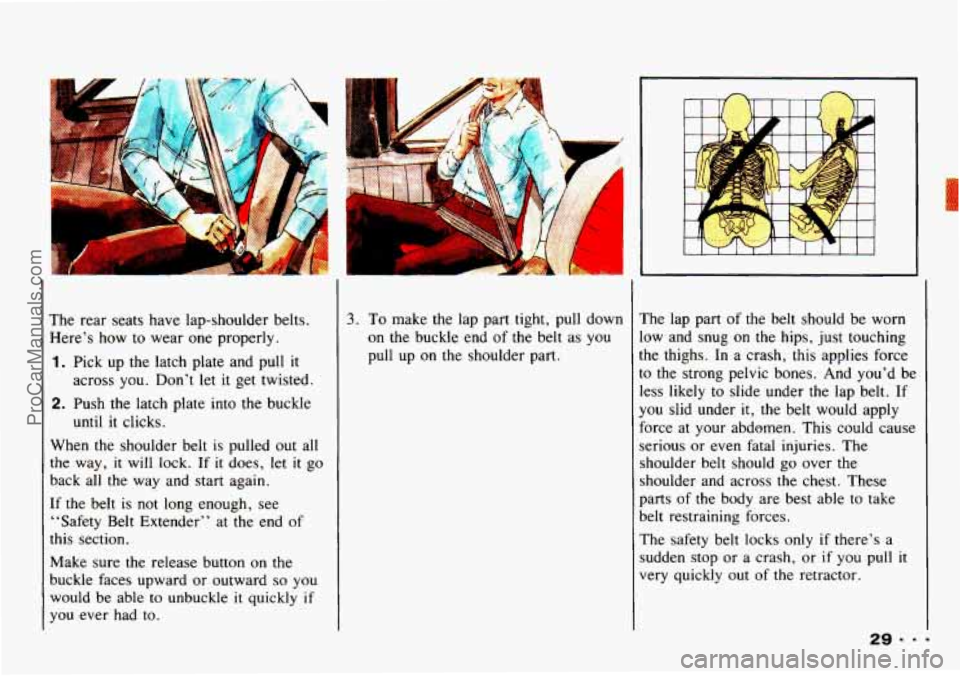
The rear seats have lap-shoulder belts.
Here’s how to wear one properly.
1. Pick up the latch plate and pull it
across you. Don’t let it get twisted.
2. Push the latch plate into the buckle
until it clicks.
When the shoulder belt
is pulled out all
the way,
it will lock. If it does, let it go
back all the way and start again.
If the belt is not long enough, see
“Safety Belt Extender” at the end
of
this section.
Make sure
the release button on the
buckle faces upward or outward so you
would be able to unbuckle
it quickly if
you ever had to.
3. To make the lap part tight, pull down
on
the buckle end of the belt as you
pull up on the shoulder part.
1
The lap part of the belt should be worn
low and snug on
the hips, just touching
the thighs. In a crash, this applies force
to the strong pelvic bones. And you’d be
less likely to slide under the lap belt. If
you slid under it, the belt would apply
force
at your abdomen. This could cause
serious or even fatal injuries. The
shoulder belt should
go over the
shoulder and across the chest. These
parts
of the body are best able to take
belt restraining forces.
The safety belt locks only
if there’s a
sudden stop or a crash, or
if you pull it
very quickly out of the retractor.
ProCarManuals.com
Page 32 of 339
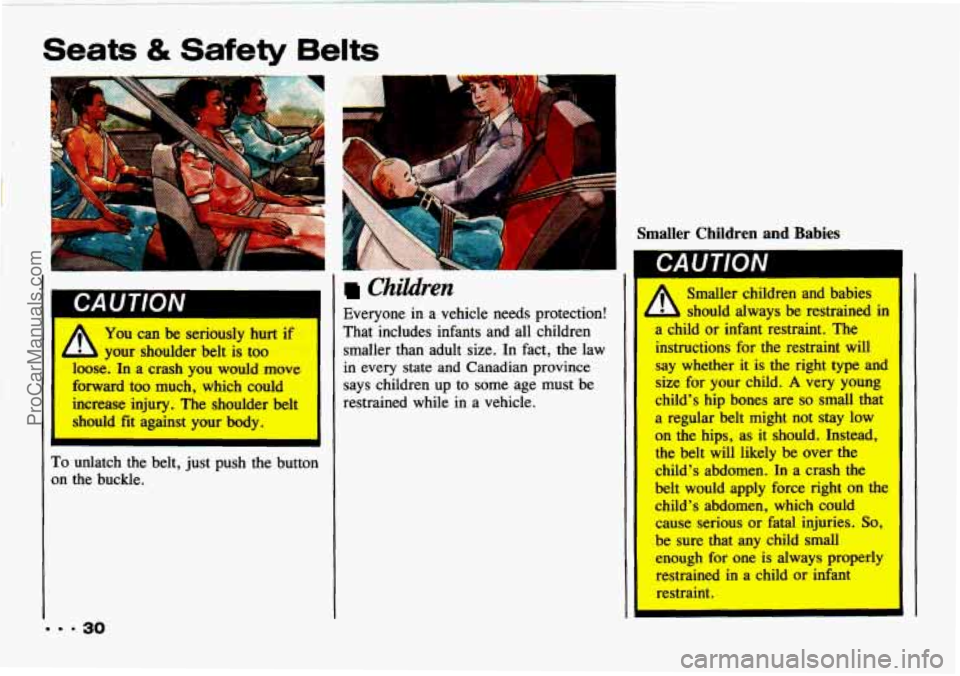
Seats & Safety Belts
4 You can be seriously hurt if
loose. In a crash you would move
forward
too much, which could
increase injury.
The shoulder belt
should fit against your body.
- your shoulder belt is too
To unlatch the belt, just push the button
on the buckle.
Children
Everyone in a vehicle needs protection!
That includes infants and all children
smaller than adult size.
In fact, the law
in every state and Canadian province
says children up
to some age must be
restrained while in a vehicle.
Smaller Children and Babies
A
Smaller children and babies
should always be restrained in
a child or infant restraint. The
instructions for the restraint will
say whether it is the right type and
size for your child.
A very young
child’s hip bones are
so small that
a regular belt might not stay low
on the hips, as it should. Instead,
the belt will likely be over the
child’s abdomen.
In a crash the
belt would apply force right on the
child’s abdomen, which could cause serious or fatal injuries.
So,
be sure that any child small
enough for one is always properly
restrained in a child
or infant
restraint.
ProCarManuals.com
Page 33 of 339
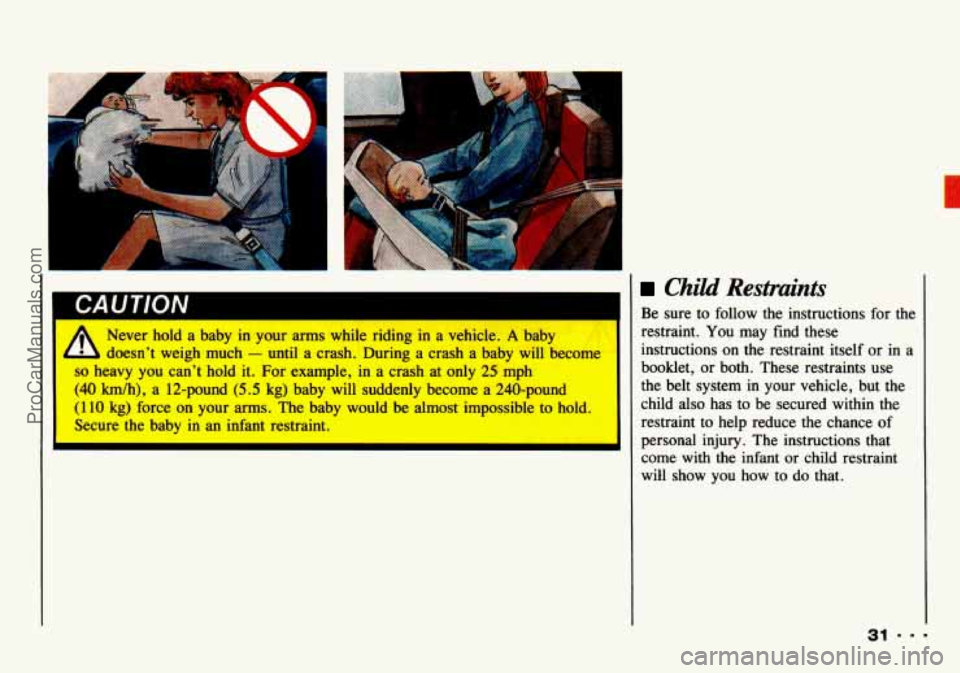
-4
UAU I IUN
Never hold a baby in your arms while riding in a vehicle. A baby
doesn’t weigh much
- until a crash. During a crash a baby will become
so heavy you can’t hold it. For example, in a crash at only 25 mph
(40 km/h), a 12-pound (5.5 kg) baby will suddenly become a 240-pound
(1 10 kg) force on your arms. The baby would be almost impossible to hold.
Secure the baby
in an infant restraint.
Child Restraints
Be sure to follow the instructions for the
restraint. You may find these
instructions
on the restraint itself or in a
booklet,
or both. These restraints use
the belt system in your vehicle, but the
child also has
to be secured within the
restraint
to help reduce the chance of
personal injury. The instructions that
come with the infant or child restraint
will show you how to do that.
ProCarManuals.com
Page 34 of 339
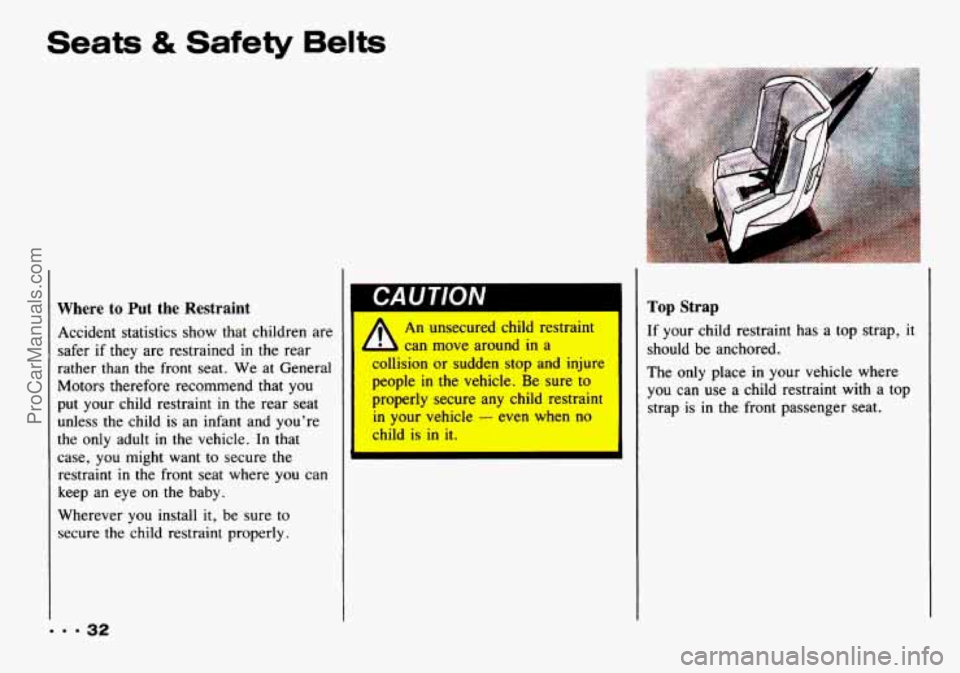
Seats & Safety Belts
Where to Put the Restraint
Accident statistics show that children are
safer if they are restrained
in the rear
rather than the front seat. We at General
Motors therefore recommend that you
put your child restraint in
the rear seat
unless the child
is an infant and you’re
the only adult
in the vehicle. In that
case, you might want to secure the
restraint
in the front seat where you can
keep an eye on the baby.
Wherever you install it, be sure to
secure the child restraint properly.
II
An unsecured child restraint
W can move around in a
ollision
or sudden stop and injure
people
in the vehicle. Be sure to
properly secure any child restraint
in
your vehicle - even when no
child is in it.
Top Strap
If your child restraint has a top strap, it
should be anchored.
The only place
in your vehicle where
you can use a child restraint
with a top
strap is
in the front passenger seat.
ProCarManuals.com
Page 35 of 339
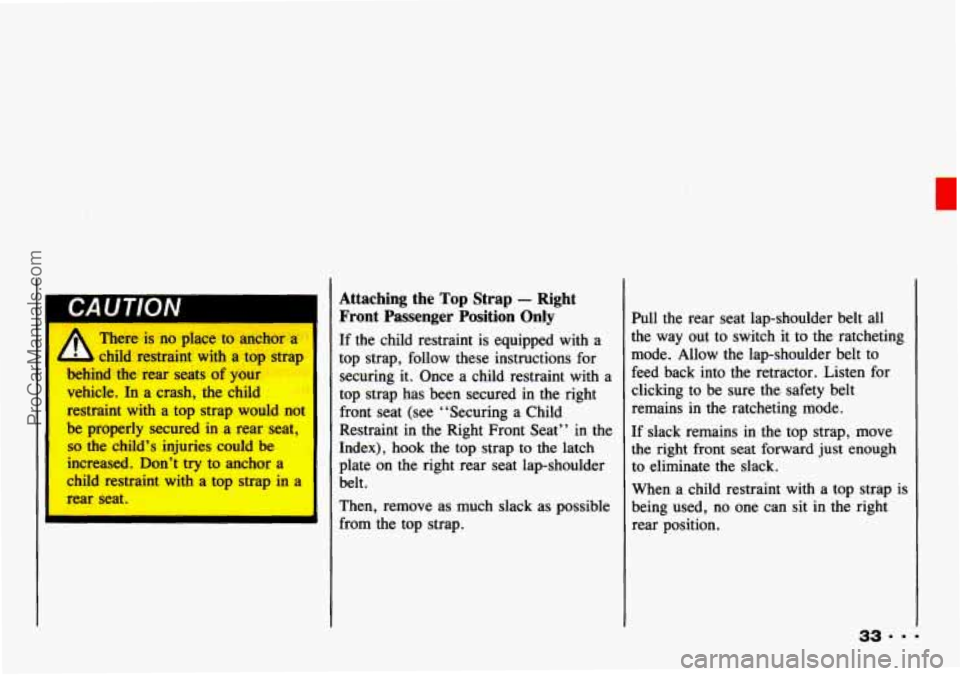
CAUTION
rn Dl A ThL,, is no place to anchor a
- child restraint with a top strap
behind the rear seats of your
vehicle. In a crash, the child
restraint with a top strap would not
be properly secured
in a rear seat,
so the child’s injuries could be
increased. Don’t try to anchor a
child restraint with a top strap in a
rear seat.
Attaching the Top Strap - Right
Front Passenger Position Only
If the child restraint is equipped with a
top strap, follow these instructions for
securing it. Once a child restraint with a
top strap has been secured in the right
front seat (see “Securing a Child
Restraint in the Right Front Seat” in the
Index), hook the
top strap to the latch
plate on the right rear seat lap-shoulder
belt.
Then, remove as much slack as possible
from the top strap. Pull the
rear sear lap-shoulder belt all
the way out to switch it to the ratcheting
mode. Allow the lap-shoulder belt to
feed back into the retractor. Listen for
clicking to be sure the safety belt
remains in the ratcheting mode.
If slack remains
in the top strap, move
the right front seat forward just enough
to eliminate the slack.
When
a child restraint with a top strap is
being used, no one can sit in the right
rear position.
33.m.
ProCarManuals.com
Page 36 of 339
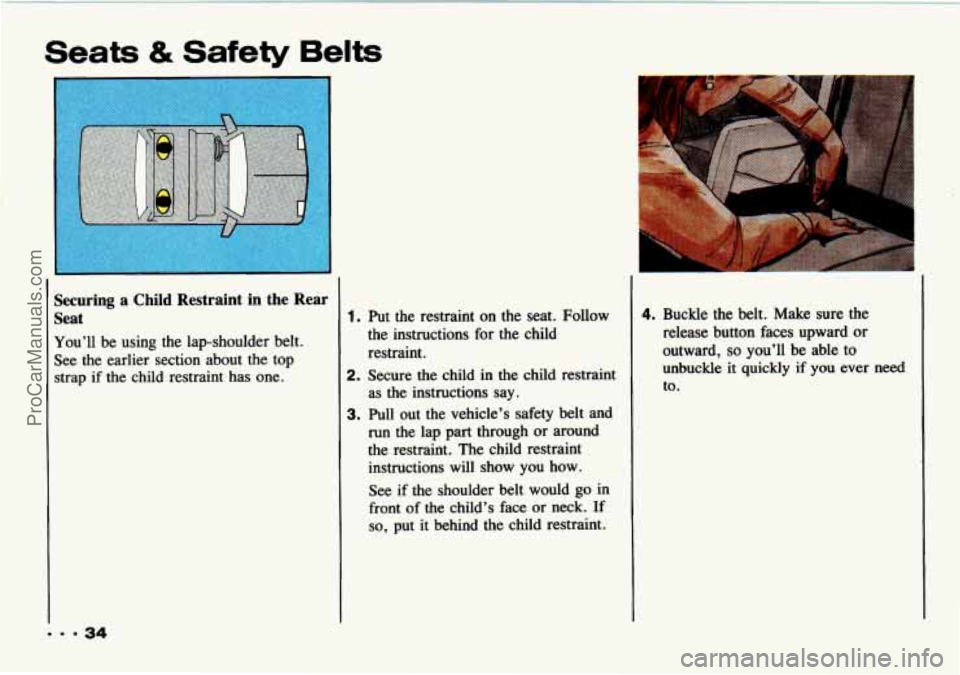
Seats & Safety Belts
Securing a Child Restraint in the Rear
Seat
You’ll be using the lap-shoulder belt.
See the earlier section about the top
strap
if the child restraint has one.
1. Put the restraint on the seat. Follow
the instructions for the child
restraint.
2. Secure the child in the child restraint
as
the instructions say.
3. Pull out the vehicle’s safety belt and
run the lap part through or around
the restraint. The child restraint
instructions will show
you how.
See if the shoulder belt would go in
front of the child’s face or neck.
If
so, put it behind the child restraint.
4. Buckle the belt. Make sure the
release button faces upward or
outward,
so you’ll be able to
unbuckle it quickly
if you ever need
to.
ProCarManuals.com
Page 37 of 339
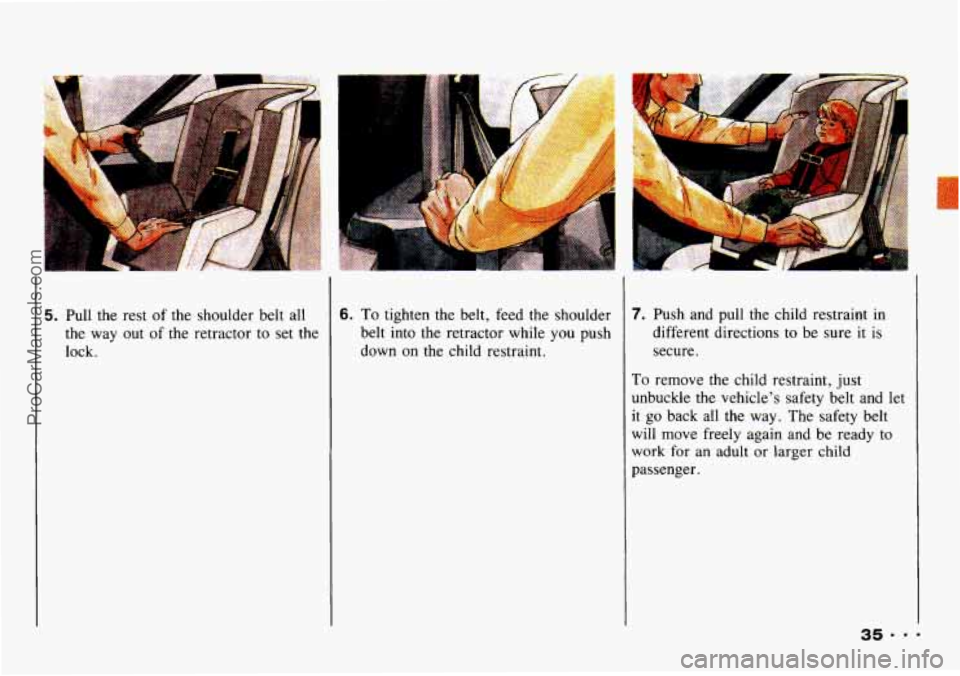
5. Pull the rest of the shoulder belt all
the way out
of the retractor to set the
lock.
6. To tighten the belt, feed the shoulder
belt into the retractor while you push
down on the child restraint.
7. Push and pull the child restraint in
different directions to be sure it is
secure.
To remove the child restraint, just
unbuckle
the vehicle’s safety belt and let
it go back all the way. The safety belt
will move freely again and be ready to
work for an adult or larger
child
passenger.
ProCarManuals.com
Page 38 of 339
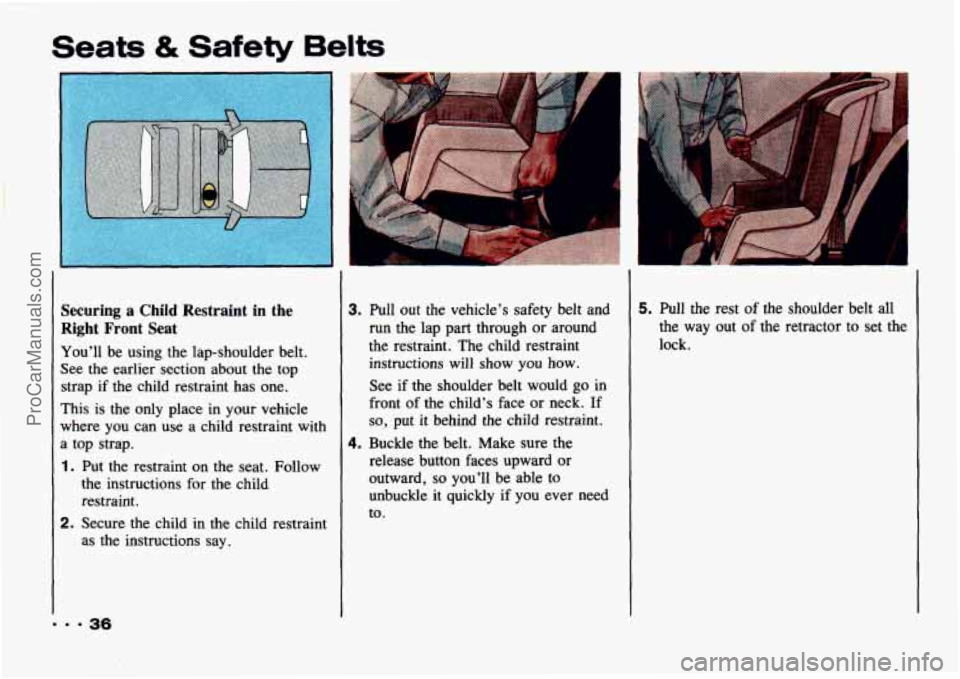
Seats & Safety Belts
I
Securing a Child Restraint in the
Right Front Seat
You’ll be using the lap-shoulder belt.
See the earlier section about the top
strap
if the child restraint has one.
This is the only place in your vehicle
where you can use a child restraint with
a top strap.
1 . Put the restraint on the seat. Follow
the instructions for the child
restraint.
as the instructions say.
2. Secure the child in the child restraint
‘9.36
3. Pull out the vehicle’s safety belt and
run the lap part through or around
the restraint. The child restraint
instructions
will show you how.
See if the shoulder belt would go
in
front of the child’s face or neck. If
so, put it behind the child restraint.
4. Buckle the belt. Make sure the
release button faces upward or
outward,
so you’ll be able to
unbuckle it quickly if you ever need
to.
b
5. Pull the rest of the shoulder belt all
the way
out of the retractor to set the
lock.
ProCarManuals.com
Page 39 of 339
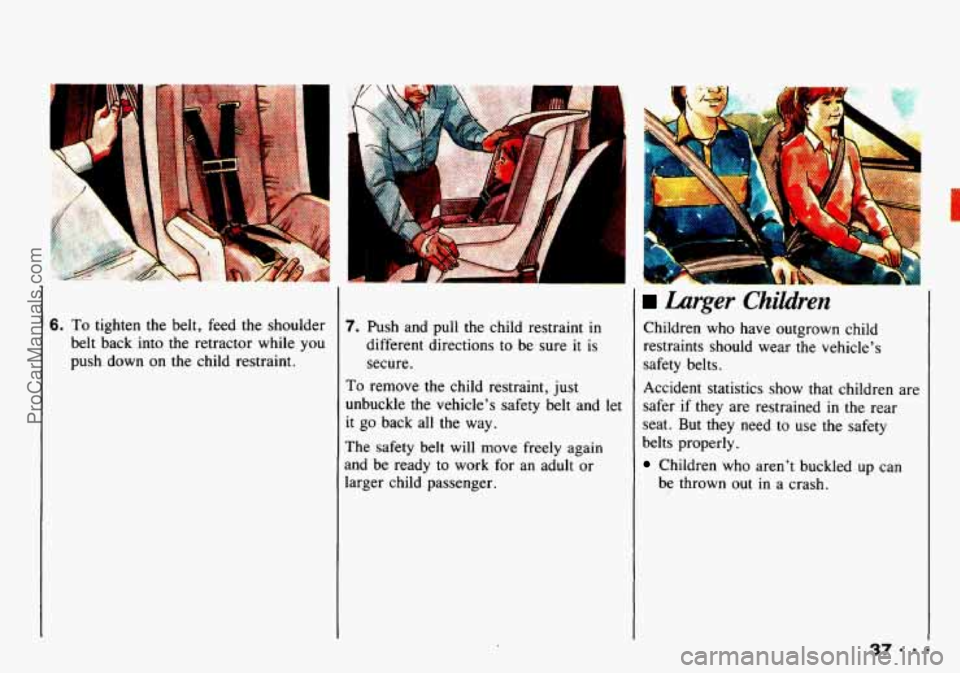
.- P
6. To tighten the belt, feed the shoulder
belt back into the retractor while you
push down on the child restraint. 7. Push and pull the child restraint in
different directions to be sure it is
secure.
To remove the child restraint, just
unbuckle
the vehicle’s safety belt and let
it go back all the way.
The safety belt will move freely again
and be ready to work for an adult or
larger child passenger.
Larger Children
Children who have outgrown child
restraints should wear the vehicle’s
safety belts.
Accident statistics show that children are
safer
if they are restrained in the rear
seat. But they need to use the safety
belts properly.
Children who aren’t buckled up can
be thrown out in a crash.
ProCarManuals.com
Page 40 of 339
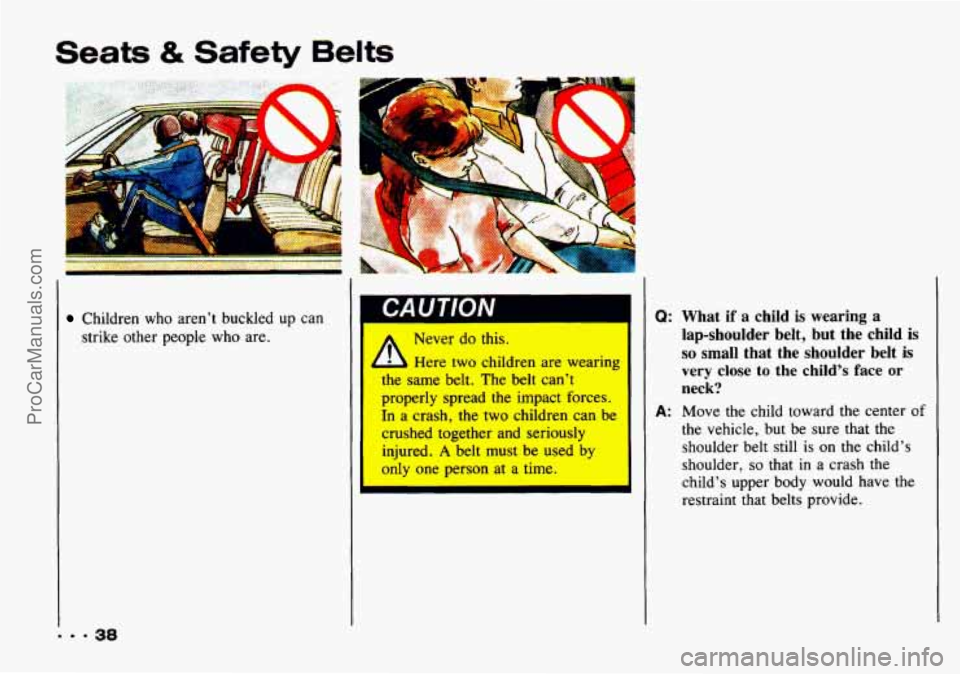
Seats & Safety Belts
Children who aren’t buckled up can
strike other people
who are.
I CAUTION
Never do this.
h Here two children are wearing I
me same belt. The belt can’t
properly spread the impact forces.
In a crash, the two children can be
crushed together and seriously
injured.
A belt must be used by
only one person at a time.
Q: What if a child is wearing a
lap-shoulder belt, but the child is
so small that the shoulder belt is
very close to the child’s face or
neck?
I A: Move the child toward the center of
the vehicle, but be sure that the
shoulder belt still
is on the child’s
shoulder,
so that in a crash the
child’s upper body would have
the
restraint that belts provide.
ProCarManuals.com